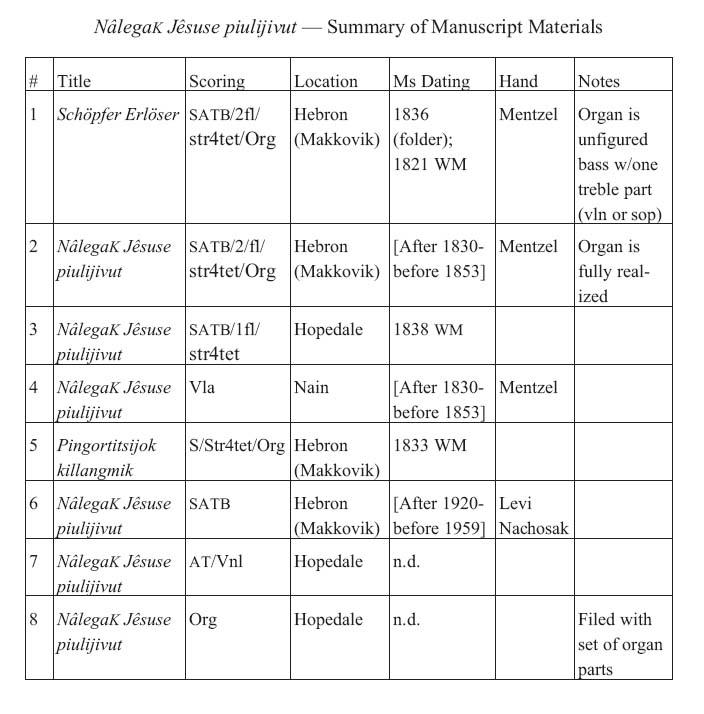Found in Translation:
The Inuit Voice in Moravian Music
Tom GordonMemorial University
tgordon@mun.ca
1 THE MOST HILARIOUS PARTY GAME of my pre-teen years was something we called "telephone." A group of excitable nine-year-olds sat in a circle as we whispered a secret from person to person around the room. As the secret advanced around the circumference of friends, it grew more distorted (and of course, more hilarious) with the incidental changes of mis-communication and colourful embellishments of each retelling. When the secret-no-more finally returned to its original whisperer, it was told aloud to convulsions of laughter. Not so long ago, the game of telephone came back to me in an unexpected déjà vu moment. My daughter and I found ourselves in a eight-passenger compartment on a European night train. Among our six fellow travellers, each had one language in common with one other person in the compartment. Armed with a translation chain, we spent one of the most memorable nights of our lives telling jokes across six languages in a circle around the car. The hilarity was not far from the level of my childhood telephone games, but the source of the distortion was not merely the creative silliness of a group of friends. Instead the metamorphosis was occasioned by successive layers of cultural inflection as the joke was retold and remoulded across six languages.
2 Both telephone games produced unexpected results — and no small amount of amusement. Both were also lessons in the fallibility of communication: to retell — to copy is to introduce error — to distort. Though on one level the transformation of the secret is a distortion, on another it is no more than the introduction of the voice of the teller. The story is thus amplified from its previous form, carrying with it the added resonance of the reteller. As Stravinsky famously said, in retort to the critics of Pulcinella, "to copy is to critique" (111-114). Copying introduces the filter of the reteller’s sensibilities and judgment which render the story retold a story new.
3 In the course of cataloguing and digitally documenting the almost 10,000 extant manuscript pages of Moravian music in Inuit congregations of the Labrador coast, I’ve had time to think about copying. These weathered sheets of music manuscript now housed in three tiny churches represent a copy chain that travelled from the tiny spiritual capital of the Moravian church in a distant corner of Saxony to the inhospitable and isolated coast of Northern Labrador across almost 200 years. The physical distance traversed is dwarfed by the cultural distance separating the German (and later British) missionaries, well-schooled in the complex musical language of eighteenth-century classicism, and the Inuit of Labrador with whom they first made contact in 1752. From early in the nineteenth century into the 1970s, first missionaries and then, increasingly, Inuit organists copied and recopied the voluminous repertoire of their annual cycle of sung liturgies, congregational hymns, and elaborate anthems. Much like musical apprentices centuries earlier, the Moravian Inuit learned their craft in part through the process of copying out repertoire by hand. The rough conditions of life in Labrador, the too-frequent church fires, and the sheer wear of enthusiastic use meant that there was a continuous need to make new copies of the music. Even though inestimable numbers of manuscripts have been lost through fires or dispersal, the Moravian predilection for recording and preserving means that few copies were lost intentionally. Thus when a new part set for a Christmas anthem entered use, the older copies were put to the bottom of the file. Much like the childhood game of telephone and the translation circle of the night train (though minus the hilarity), the cultural critique and the creative act of retelling can be traced across generations of these copies. This corpus of manuscript material offers a wealth of opportunities to consider the art of retelling a musical idea on paper, as well as the particular voice of the retellers of this repertoire, the Moravian Inuit musicians of Labrador.
THE MORAVIAN MISSION AMONG THE LABRADOR INUIT
4 A living (though diminished) practice, the Moravian music of the Labrador Inuit is a cultural hybrid that has evolved in relative isolation across more than 200 years. The Moravian missionary efforts among the Inuit began in Greenland in 1733. Twenty years later, working with the understanding that the Labrador Inuit spoke the same language as the Greenlanders, a group of London Moravians funded a trading and missionary voyage to the Labrador coast. A mission house was built at Nisbett’s Harbour, but the expedition ended in tragedy when its leader, Johann Christian Ehrhardt, and six companions, were killed by Inuit. The idea of a Labrador mission was taken over by another Moravian, Jens Haven. After the end of the Seven Years War in 1763, Haven met the governor of Newfoundland, Sir Hugh Palliser, who believed that the Moravians might be very useful in putting an end to the Inuit’s frequent raids on European fishing stations in southern Labrador. In 1771, with permission to "occupy and possess 100,000 acres at Esquimaux Bay," Jens Haven and thirteen other English and German missionaries established their first settlement at Nain. Two more stations were soon erected: to the north at Okak in 1776, and to the south at Hopedale in 1782. Each station consisted of a communal dwelling house, a church, a trading store, and various outbuildings. The early years of the mission were difficult and the process of conversion slow and discouraging. A breakthrough occurred in the early nineteenth century and by 1818 some 600 Inuit were attached to the three stations, as baptized Christians living within settled communities. The mission expanded over the next century, establishing an important station further north at Hebron in 1830. The largely settler community of Makkovik received a mission in 1896. During the nineteenth century there were between 30 and 40 missionaries on the coast at any one time, most of them German. All learned Inuktitut, which was the language used in church and school, and they usually remained in Labrador for long periods of time. The annual visit each August of the supply and trade vessel — usually named Harmony — was the Moravians only link with the outside world. Significant challenges came with the twentieth century. The station at Okak was closed in 1919, its population decimated by the Spanish influenza epidemic ironically introduced by the annual visit of the Harmony that year. After World War II, the Labrador church headquarters moved to the flourishing community of Happy Valley and with Newfoundland’s entry into the Canadian Confederation in 1949, the now provincial government took over the Moravian schools, changing the language of instruction from Inuktitut to English. In a highly controversial move, the community of Hebron was closed in 1959 and its population moved to the remaining settlements. Today there are active Moravian congregations in Nain, Hopedale, Makkovik, and Happy Valley, with the first two being principally Inuit congregations. Of the 2,500 Labrador Inuit living on the north coast, approximately 2,000 identify themselves as Moravians; the number of adherents is dramatically smaller.
THE REPERTOIRE AND THE WORK CHOSEN
5 The liturgical performance of mixed chorus anthems with the accompaniment of strings, organ, and obligato winds resonated continuously in the tiny and isolated churches of coastal Labrador for over 200 years. Virtually removed from contact with an outside musical world until the relatively recent advent of radio in the North, the performance of this repertoire remained "uncontaminated" by influences other than the periodic arrival of younger missionaries and the evolving aesthetic preferences of the Inuit performers. The minuscule population of this geographically dispersed community precluded the publication of any liturgical music beyond the voluminous collection of hymn texts.1 Thus the entire Inuktitut language anthem repertoire exists only in hand-copied manuscript form. Despite the extensive loss of materials due to church fires and dispersal, the extant corpus of manuscripts is fairly extensive. To date, the inventory of manuscripts has identified a total of 177 anthem titles representing 155 distinct musical works (taking into account that a number of works exist in two or more arrangements or with two or more different texts). A total of just under 10,000 manuscript pages is distributed across three congregation collections.2 In the ongoing exercise of cataloguing the works in this collection, 81 percent have been identified by composer, 88 percent have been identified by German or English title, and 73 percent have been correlated to manuscripts held by the Unitäts-Archiv in Herrnhut or the American collections indexed by the Moravian Music Foundation (Cumnock, Gombosi, and Steelman).
6 The work chosen to explore the telephone chain of copies is an SATB anthem with strings, organ, and obligato flute found in all three Labrador collections, most often under the title NâlegaK Jêsuse piulijivut. Its selection is not due to the fact that it is an especially distinguished piece of music; it is not. Unlike a few genuine treasures uncovered in the course of this research, NâlegaK Jêsuse piulijivut employs conventional material in a formulaic way.3 Further, while NâlegaK Jêsuse piulijivut was obviously a popular work at its time, it fell out of the active repertoire sometime ago.4 Although the composition itself may offer minimal interest, the trail of manuscript copies leads us on a fascinating journey from Dresden and Herrnhut to the length of the Labrador coast. At least three generations of hands span more than a century of copying and reconsideration.
7 NâlegaK Jêsuse piulijivut was composed by Johann Gottlieb Naumann (1741-1801) and first entered the Moravian repertoire on 13 November 1781 under the title Schöpfer Erlöser, Herr Himmels.5 Like a great many Moravian anthems, Naumann’s Schöpfer, Erlöser is a contrafactum, a new text set to already composed music. Naumann, a Dresden opera composer and Kappelmeister of wide reputation, provided it to the Moravian Brüdergemeinde after having learned of their musical practices through a Dresden family connected to the Church. Schöpfer, Erlöser is one of several anthems he eventually produced for the Moravians.6 In this case, the first life of NâlegaK Jêsuse piulijivut/Schöpfer, Erlöser was as Geist aller Welten, the Chorus of Priests from Act 1, Sc. 3 of his 1780 opera Cora und Alonzo.7 The music belies its roots in opera seria both in its ceremonial style (the tempo indicated is Allegro staccato e maestoso) and in a musical language that was already slightly archaic at the time it was written.
8 Schöpfer Erlöser, Herr Himmels is characterized by simple tonal materials of high contrast in an efficient and compact binary form. The tempo, Allegro staccato e maestoso, is unusual in its combination of a common allegro-qualifier maestoso with the less common staccato. Together, the two qualifiers confirm the essential style of the work as a static tension produced by persistent dotted rhythms and the simple stepwise melodies which never venture out of the ceremonial triple metre. This signature "affect" is put in relief by the textural contrast of occasional points of light imitation. A 24-measure instrumental introduction establishes the primary motivic and harmonic material of the anthem. The A material (Mus. ex. 1) is a straightforward tonal melody describing the tonic and subdominant triads in largely stepwise movement. The notable moment in this tune is its downward leap of an octave (and return) just prior to the first rest (m. 3-4). The second half of the phrase employs a brief chain of secondary dominants in close movement to approach a half cadence. Harmonized by the three lower voices in block chords, when the A material is taken over by the chorus it is animated by dotted rhythms in the accompanying strings. A point of faux imitation inaugurates the modulation to the dominant which is effected by m. 47. The B material (Mus. ex. 2) is an extravagant arpeggiation spanning a minor thirteenth — a gesture operatic enough in its proportions to incite recomposition at the hand of later copyists. The excursion to the dominant is brief: G is established as a pedal which prepares the return to the tonic over twelve measures. C major is re-established at m. 75 with the return of the point of imitation from m. 32. The B motive arpeggiation returns at m. 92, now transposed to C major and taking the sopranos to c3, well outside the range of most church singers. The coda enters at m. 98 with a more developed point of imitation before the solid chordal finish and the instrumental postlude of six measures of dotted arpeggiations.
Musical Example 1. Naumann, NâlegaK Jêsuse piulijivut, mm. 1-8 from ms. 1
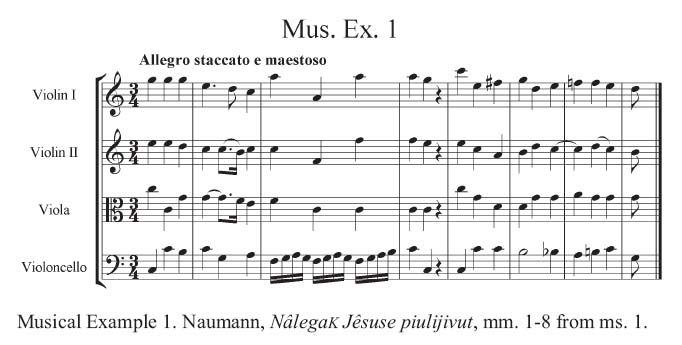
Display large image of Figure 1
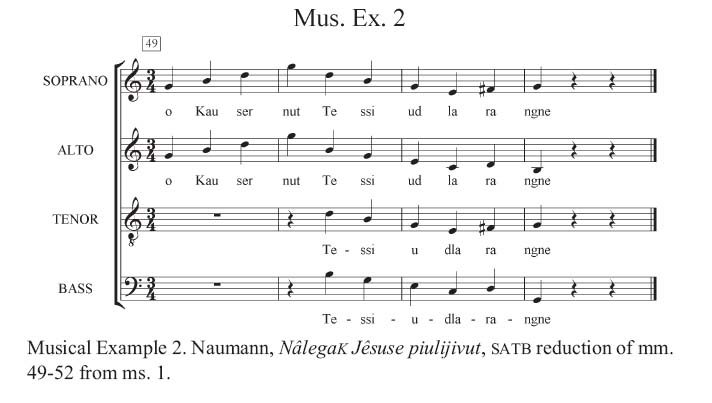
Display large image of Figure 2
Section, Key, Measure

Display large image of Table 1
9 Though unexceptional in its materials, Schöpfer Erlöser, Herr Himmels effectively establishes vertical and horizontal contrasts that create a sense of drama on this small-dimensioned musical canvas. The frequent tension of the articulated dotted rhythm accompaniments against the homorhythmic movement of the voices achieves the "staccato e maestoso" imperative of the tempo marking. Structural contrast is introduced by the sections which at least suggest points of imitation, through pairings of voices and through the division of the accompanying ensemble into two or more instrumental choirs. These contrasts were further enhanced by the original scoring of the anthem which was for SATB chorus, strings, organ, and an obligato wind section that included two flutes, two oboes, and two horns.8 The fact that the original Hebron manuscript includes only flutes, is reflective of the copy-ist’s knowledge of feasible resources in the Labrador missions.
MANUSCRIPTS OF NÂLEGAK JÊSUSE P IULIJIVUT IN THE LABRADOR COLLECTIONS
10 NâlegaK Jêsuse piulijivut was among the first generation of anthems to enter the repertoire of the Labrador mission churches. And the manuscript evidence suggests that it rapidly spread among the mission stations.9 The earliest set of manuscript materials is now found in the Makkovik collection in a coarse brown folder labelled "Hebron 1836." In addition to two generations of subsequent copies, this folder contains three double-page, large-format manuscript sheets. The paper is hand-ruled and watermarked "Smith & Allnut 1821." The status of this set of materials as the earliest is confirmed by the German-only text on both the SATB part set and on the short score, as well as by the fact that the Inuktitut translation appended to the choral score was subsequently revised substantially by a Hebron translator.
Smith & Allnut 1821

Display large image of Table 2
11 From this initial set of parts, performance copies were made for the Hebron congregation. In addition to a full set of string parts, a pair of flutes, and a fully realized organ part, there are multiple copies of some choral parts (three soprano parts, two tenor parts, and one each of alto and bass). The parts are on commercially ruled paper, but in the same hand as the original materials. In this set, the text is in Inuktitut only, and the translation differs substantially from the one appended to the original open choral score. It does, however, correspond directly to a translation found on page ten of the Hebron register of anthems and translations. In addition to this part set, there is a later set of choral parts (S:1/A:2/T:1/B:2) in the hand of Inuit organist Levi Nachosak which likely dates from the second quarter of the twentieth century.
12 Although the Hebron mission was only established in 1830, it quickly developed a musical activity as vibrant as that of Nain which had been founded almost 60 years earlier. While Nain received its first organ in 1824, correspondence from Brother Jonathan Mentzel reveals that an organ arrived in Hebron "in good condition" on the annual mission ship in 1831.10 Mentzel,11 an ordained minister and cabinetmaker, took responsibility for much of the musical activity at Hebron. His legacies included a substantial manuscript collection of anthems and several generations of Inuit musicians whom he taught choral singing, brass, wind and string instruments. His correspondence across his entire tenure in Hebron (1830-1853) confirms the high level of musical activity in that community.
13 It seems likely that this original Hebron part set for NâlegaK Jêsuse piulijivut was copied by Mentzel during his 1831 furlough in Herrnhut. Having already been assigned to establish the Hebron mission, Mentzel returned to Germany for the 1830-1831 winter to be ordained and to marry. With the knowledge that his duties in Hebron would include music for the church, he took advantage of his time in Herrnhut to copy several manuscript sets to take back with him to Labrador.12 Mentzel would have had a functional knowledge of Inuktitut, having already spent ten winters on the Labrador coast in Okak, Hopedale, and Nain and could have made the first translation into Inuktitut while copying the manuscript in Germany. The performance parts would have been made subsequently in Labrador and the translation substantially revised on site.
14 Mentzel’s original copy of materials for Schöpfer Erlöser, Herr Himmels made an early voyage from Hebron to Hopedale where another set of performance parts was made for use in that congregation as early as 1838. Although now missing first violin and organ parts, as well as the final 25 measures of the second violin part, the full score is easily assembled from the extant parts. The use of Mentzel’s pre-revision translation of the text into Inuktitut confirms that the 1831 original copy is the source for this part set. But the musical materials themselves reveal that a fairly substantial degree of re-composition was already incorporated in this early copy of parts. A scattering of later copies of individual parts (two alto, one tenor, and two first violin parts) in the Hopedale file confirms the general directions of this re-composition (discussed below).
15 A single viola part in Jonathan Mentzel’s hand now held in the Nain congregation collection, together with the inclusion of the title on service orders from the second decade of the twentieth century, also establishes that NâlegaK Jêsuse piulijivut was in the active repertoire in Nain, and very likely in Okak as well, since a large proportion of the manuscripts now in Nain came from Okak when the community closed in 1918. The majority of pre-twentieth century manuscripts made for the Nain congregation had been lost through a succession of church fires.
16 A final piece of manuscript evidence in the telephone chain of copies of NâlegaK Jêsuse piulijivut is what appears to be an early, made-in-Labrador contrafactum. Pingortitsijok killangmik is a Christmas anthem for solo soprano with strings and organ, using material drawn from the body of NâlegaK Jêsuse piulijivut. Several unusual features, particularly the short score watermarked "J. Coles 1833," suggest the intervention of Inuit musicians in the copying/creation of this set of materials.
NâlegaK Jêsuse piulijivut — Summary of Manuscript Materials
THE 1836 HEBRON PART SET
17 The chain of copyists’ re-compositions begins first with Mentzel’s set of performing parts (#2). Reflecting the performance practice conventions of the day, this part set constitutes a realization of the skeleton represented in the original materials (#1). Since it serves partly pedagogical purposes (it would be among the first scores taught to the Hebron Inuit musicians), this part set is in some respects even more European in conception than the original set. It renders transparent the opaque musical shorthand of the first set of materials. Thus one of the most significant differences from the original copy is in the realization of the continuo part and of ornamentation. Here embellishments are written out, as a comparison of the first violin part in mm. 5-8 in the original copy (#1— Mus. ex. 3a) and the first set of performing parts (#2 — Mus. ex. 3b) illustrates. The realization of these ornaments (as well as the realization of the keyboard part, an unfigured bass with soprano line in the original materials) is accomplished with considerable skill and understanding of the style. Ornaments are not consistently indicated when passages repeat (e.g., the accacciatura in the second violin at m. 6 is not repeated at m. 30 with an otherwise identical figure). Nor are they indicated consistently across the texture (e.g., the pre-cadential trill in the second violin at m. 4 presumably belongs in the first violin as well). However, there are sufficient instances of ornaments realized on which to base a performance pedagogy of late Baroque ornamentation.
Music Example 3a. Naumann, NâlegaK Jêsuse piulijivut, Violin 1, mm. 5-8 from ms. 1
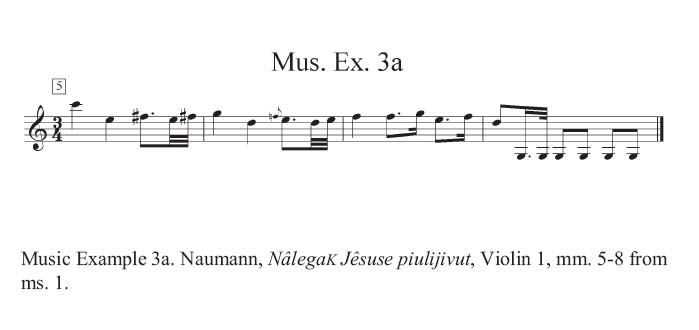
Display large image of Figure 3

Display large image of Figure 4
18 A further signature feature of this part set is found in the way in which the qualification staccato in original tempo marking is interpreted across the parts. Repeated only on the first violin, cello, and organ parts of the original part set, the tempo is rendered simply as "allegro maestoso" on the instrumental parts in the 1836 Hebron set. But the staccato element is upheld in numerous details that encourage a crisp articulation from the performers. These include carrying over the staccato markings from the original material (violins mm. 83 + 98-99), in both instances at points where they set up a point of harmonic and textual climax achieved in full legato. The articulation is made most incisive through the attempt to establish a consistent rhythmic motive to accompany phrase elisions. Variously rendered in the original (perhaps as a kind of shorthand), the 1836 Hebron part set standardizes this rhythm to a sharply articulated form (Mus. ex. 3a, m. 4) in each of its subsequent appearances at mm. 8, 32, 62, 74, and 101. The tambour-like figure of the dotted sixteenth/thirty-second note exaggerates the ceremonial character of the figure with a near militaristic rhythmic incision.
19 The amount of actual re-composition in this part set is minimal. With the same copyist and little time separating the original copy and the first part set, there was scant cause for reconsideration. But a few minor changes between these two sets of material are worth noting. Two pitch changes are consistently enough applied to rule out the possibility of transcription error. Both occur at exposed points in the composition and can be interpreted as "artistic" decisions. The first is the revision of the octave leap in the opening phrase to a minor sixth (Mus. ex. 4a and 4b). The effect of this change (which is repeated at the parallel passage after the choir enters, m. 27) is to eliminate the dramatic gesture of the open octave leaps and to maintain a fully spelled subdominant triad through the complete measure. With no technical reason for the change, it is clear that the revision represents a preference for the more harmonic sonority over the dramatic melodic gesture.
20 A second significant pitch change occurs when the B material is restated in the tonic near the end of the anthem (Mus. ex. 5a and 5b). A literal transposition to C major takes this unison arpeggiation in the treble voices well outside the range of a church choir singer. Although range alone justifies revision on completely pragmatic grounds, the particular compositional choice made by the copyist again supports a preference for harmonic sonorities over the dramatic gesture. By locking the sopranos and altos into parallel thirds a beat earlier, the revision breaks off the bold gesture of a unison octave arpeggiation before it reaches its goal. Faced with the same registral predicament, Herrnhut copyists chose to transpose the entire anthem down to B= or A=. As we shall see, the Labrador copyist responsible for the Hopedale part set didn’t feel the high Cs would be problematic for his choir. One final pitch change occurs at the return of the A section (mm. 74-79). Here the tenor closes its first phrase falling a third to E, rather than a fifth to C. The change maintains strict canon between the soprano and tenor voices and fills in the tonic harmony in m. 79. In the original version, all voices cadenced in unison on the pitch C in this measure. Again, the re-compositional choice favours harmonic resonance over dramatic gesture. The preference for resonance is also signalled in another minor notational change found in the 1836 Hebron parts. The substitution of half notes for quarter notes in the choral cadence resolutions obviously prolongs the harmonic sonority of the mixed voice choir.
Music Example 4a. Naumann, NâlegaK Jêsuse piulijivut, Flutes and strings, mm. 1-4 from ms.1
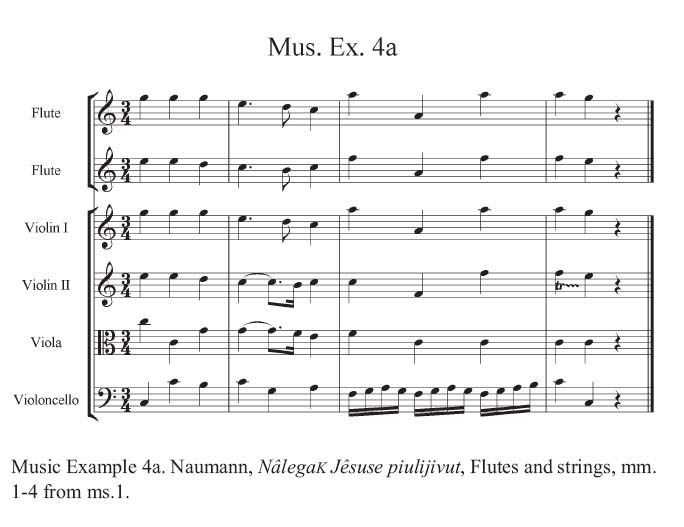
Display large image of Figure 5
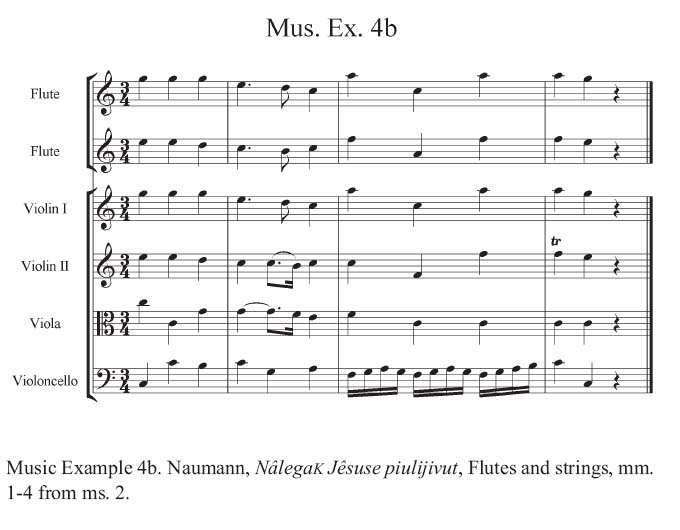
Display large image of Figure 6
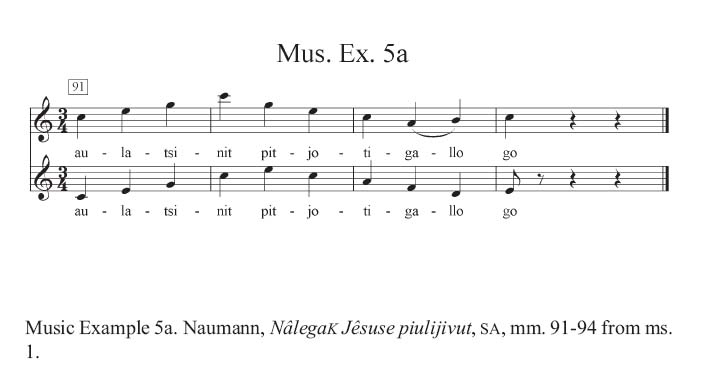
Display large image of Figure 7
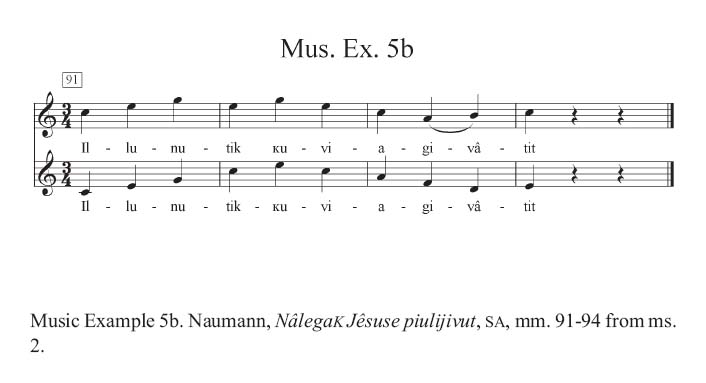
Display large image of Figure 8
21 Although few in number and relatively minor in their impact, the emendations introduced into this first Labrador part set nevertheless forecast the types of revisions which will emerge across the chain of re-compositions. While many of the changes will be occasioned by purely pragmatic considerations (tessitura, available instruments, abilities of performers), the choices made already favour harmonic resonance and blended choral sonorities. At the same time, the 1836 Hebron part set maintains and enhances the dramatic gestures and effects carried over from the original operatic source through a sharpening and clarification of rhythm and articulation and through the maintenance of the contrasting juxtapositions of distinct "choirs" within the instrumental and vocal ensemble.
THE EARLIEST HOPEDALE PART SET
22 The earliest part set now held in the Hopedale collection (#3) dates from not long after the 1836 Hebron part set. In a missionary hand and entered on paper that can be dated to 1838, it is clear that this set of parts was made from the original copy (#1) of Schöpfer, Erlöser since it faithfully duplicates the Inuktitut translation of the text found on the original copy. However, the copyist was far more liberal in his treatment of the musical text which manifests a number of significant discrepancies against the original copy and the Hebron 1836 set.
23 The general drift of re-composition is signalled immediately in the change of the tempo indication: "Allegro staccato e maestoso" becomes "Maestoso." Thus the tempo is not only slowed, but the character of the work will be defined less in crisp articulation and more in the weight of sonority. The change in tempo is accompanied by a change in scoring: instead of two obligato flutes, there is but one. And this single flute doubles the first violin throughout. Neither is there an organ part in the same hand as this set of choral and instrumental materials. A fully compatible organ part in what appears to be a slightly later hand exists with the Hopedale materials. But clearly this part set was conceived with the possibility of a performance with only one (or even no) flutes and with the presence or absence of an organ. The pragmatic consideration of available performing resources is an obvious justification for such a rescoring. However the exact nature and direction of the re-composition reveals a number of consistent and very distinct aesthetic preferences.
24 Among the first and most evident is the reduction of elements of stylistic self-consciousness. Quick to disappear from the string parts are the elegant ornaments which were carefully added in the 1836 Hebron manuscript. Although in other communities it might be safe to assume that the written out ornaments were notationally superfluous, Baroque performance practice style could not be assumed to be in-grained among the Hopedale musicians. The suppression of ornamentation as an aesthetic preference is further suggested by the elimination of the crisp tambour rhythm that had been so carefully standardized at cadential elisions across the 1836 Hebron manuscripts. Here the is simplified to or simply to a series of undifferentiated eight notes. Elsewhere in this set of copies the propulsive effect of dotted rhythms is repeatedly neutered through the substitution of undifferentiated eighth notes.
Figure 1

Display large image of Figure 9

Display large image of Figure 10
25 In addition to the suppression of melodic and rhythmic ornamentation, there are several other reductions introduced into the Hopedale copies which further obscure the stylistic refinements of the anthem’s operatic roots. Any residual hints of virtuosity are purged from the string parts, notably through the elimination of all double and triple stops that served to articulate new points of departure in the second section of the piece. In addition, the strings and flute consistently manifest less independence from the choir than in the original copy and the Hebron manuscript. Even where unnecessary, the strings are now much more likely to double the voices. The result of a considerable number of fine detail changes is a score which is much more homogeneous, devoid of eccentric effects, and most evidently characterized by its clarity of text presentation and efficient tonal progress. Against this general trend toward reduction in dramatic effect stands, in contrast, the copyist’s decision to retain the high C in the soprano part at mm. 92 and 96 (the Hopedale parts maintain the soprano and alto parts as indicated in the original copy, cf. Mus. ex. 5a). Beyond these general and consistent emendations, the Hopedale copyist significantly re-scored one complete passage. Although the impetus for the re-scoring is clearly the available performance resource, the new version once again supports a consistent preference for homogeneous sonority over dramatic effect.
26 The passage in question (Mus. ex. 6a and 6b) is first heard in the instrumental introduction where it bridges the first full statement of the A material to the cadence which prepares the choral entry.13 The re-scored repetition of the same material in question and answer phrase structure suggests a theatrical echo effect, reminiscent of the material’s operatic source. In the original copy (Ms. 1, Mus. ex. 6a), the material is distributed across three distinct instrumental "choirs": flute duo / upper strings / lower strings. These three "choirs" are each characterized by an individual identity defined by instrumental colour and register. The simple melodic turn is sounded first in the flutes to an arpeggiated accompaniment in the upper strings and a pedal in the lower strings. Then on repetition the choirs exchange parts: the melodic interest is recast and assigned to the upper strings while the accompanying figure is sounded in octaves in the viola and cello, all beneath an upper pedal in the flute. The Hopedale re-composition of the material (Ms. 3, Mus. ex. 6b) dissolves the independence of the three instrumental choirs and recasts the same material in a more homogenous texture. Here, in its first statement the melodic pattern is first assigned to the flute and first violin in unison, doubled at the tenth below in the viola. The alberti accompanying figure, sounded in the lowest register of the second violin, occupies the same registral space as the viola. The pedal is nearby in the upper octave of the cello. On the varied repetition, the melodic interest is carried by the second violin and viola, close to one another in middle register. The flute and first violin double on the upper pedal, while the alberti accompaniment is sounded by the cello alone in one octave.
Music Example 6a. Naumann, NâlegaK Jêsuse piulijivut, Flutes and strings, mm. 9-17 from ms. 1

Display large image of Figure 11
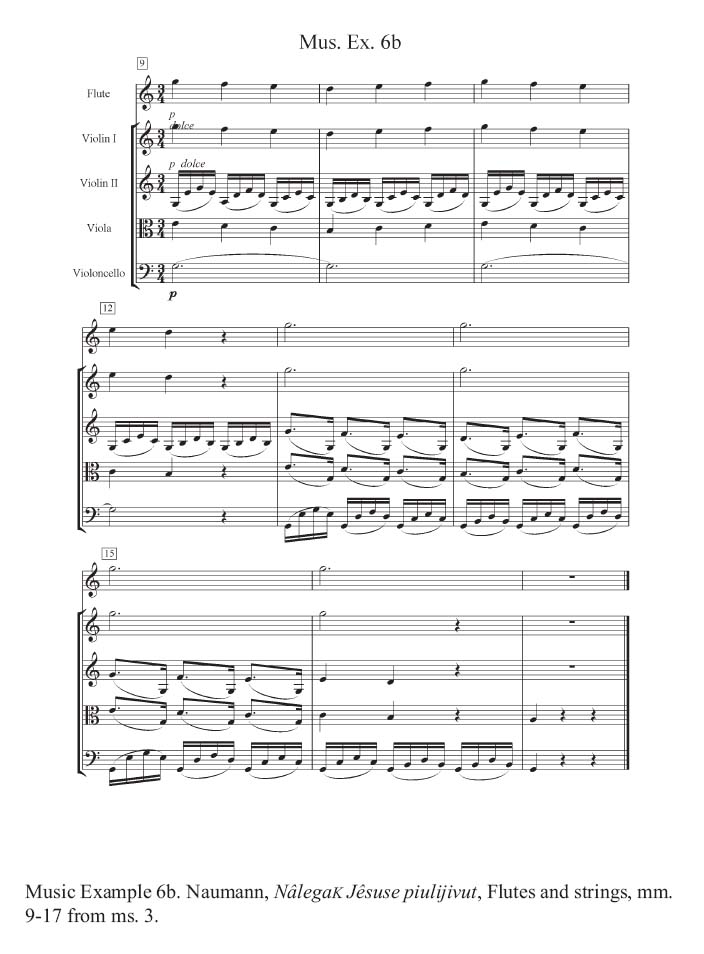
Display large image of Figure 12
27 On the first level, the purest pragmatism can be seen to motivate this re-scoring. The Hopedale version can be performed without flutes or the organ with no loss of the musical material. The copyist was intimately acquainted with the realities of performance in the Labrador mission churches. But much more than a pragmatic streak is revealed by this version. The Hopedale version of NâlegaK Jêsuse piulijivut manifests clear stylistic preferences. Dramatic contrasts and effect are eschewed. Sonorities are less Baroque: more blended in texture and timbre. Miniaturized though they were, the tambour rhythm, the suggestions of elaborate ornamentation and the stratification of instrumental colours in the 1836 Hebron version cast this innocent anthem on a stage of Baroque dramatic effects. The Hopedale version is cast in a simpler, blended texture, highlighting the abilities and, no less importantly, the preferences of its performers. Moving another stage around the telephone circle, the Hopedale manuscripts of NâlegaK Jêsuse piulijivut present the anthem retold a little more in the voice of the Inuit performers.
LATER COPIES AND A MADE-IN-LABRADOR CONTRAFACTUM
28 This hypothesis would seem to be confirmed by a scattered sampling of parts further down the copy chain. These include two later copies of first violin parts and a miscellany of choral parts in Hopedale (#7) and a complete set of choral parts from Hebron in the hand of Inuit organist Levi Nachosak (#6). Although these do not represent a coherent, full set of parts in the same sense that the earlier Hebron or Hopedale sets do, taken together they offer a fair glimpse of the story nearer the end of the copy chain. The later Hopedale parts all substantiate the drift of the nineteenth-century manuscripts in that church: ornamentation is eliminated, dotted rhythms evened. The resonant choral sonority is supported and sustained by duplication in the instruments.
29 Levi Nachosak was one of several Hebron organists active in the first half of the twentieth century. He was also a prolific copyist, responsible for the largest portion of extant manuscripts dating from the last half century of the Hebron mission. His set of choral parts for NâlegaK Jêsuse piulijivut (S:1/A:2/T:1/B:2) would have been sung with the 1836 Hebron instrumental parts and maintains fidelity to the general outlines of that set. The changes against the choral parts in that set are minor, but continue to highlight the preference for sustained choral sonorities. The most common change is the substitution of half notes for quarters on cadential sonorities, a substitution that Nachosak introduces five times. In the only other substantive change, Nachosak eliminates the seventh in the final pre-cadential dominant (m. 105, soprano).
30 By far the most intriguing set of materials generated from Johann Gottlieb Naumann’s opera chorus-turned-anthem is a second-generation contrafactum that appears to have been made in Labrador. Within the Hebron collection is a small set of materials for a solo soprano anthem entitled Pingortitsijok Killangmik (#5). The materials are in three hands
- Parts for first violin, viola, and violoncello on large format, pre-ruled paper in a missionary hand. These parts are titled both in German (Schöpfer, Erlöser) and in Inuktitut (Pingortitsijok killangmik).
- Parts for soprano, first violin, and second violin on small sheets of hand- ruled paper in an Inuit hand with Inuktitut text and titles only (Bingurtitsikok killangmik Nunamik).
- A treble/bass short score on landscape orientation, large format, hand-ruled paper. The paper is watermarked "J. Coles 1833" (Facsimile 1). This short score draws its treble part as a verbatim copy of the Hebron 1836 first violin part for NâlegaK Jêsuse piulijivut; the bass part is a carefully considered amalgam of the cello and fondamento bass lines from the same part set. In contrast to the sophistication of the hybrid bass line, the actual notation of the score itself is extremely primitive. The copyist was clearly unaccustomed to transcribing polyphonic music: the treble and bass parts are never aligned, making the score virtually illegible for performance purposes.
A further anomaly in this part set is that the short score is 32 measures longer than the soprano and string parts, including as it does a 24-measure introduction and eight-measure postlude. With the exception of the lower string parts, this contrafactum appears to be the work of Inuit musicians. As such, it offers compelling evidence on their preferences. And that evidence strongly points toward the preference for blended harmonic sonorities, neutral rhythmic activity, and an almost complete banishment of ornament or decoration.
31 The solo soprano part in Pingortitsijok Killangmik is lifted literally from the choral soprano line of NâlegaK Jêsuse piulijivut. At two points, individual pitches from other parts are integrated into the soprano line to enhance continuity and movement.14 In addition to these slight changes, the entire tenor passage from m. 67 to m. 70 is also transferred to the soprano part in Pingortitsijok killangmik. At this point in the original the tenor/bass duo responded to the soprano/alto duo of the preceding four measures. Moving the tenor part to the soprano, but maintaining it in tenor register (an octave below the soprano’s preceding four measures) upholds the registral contrast of the original.15
Figure 3 : Facsimile. Naumann, Pingortitsijok Killangmik, Short Score

Display large image of Figure 13
32 More revealing than these soprano revisions is the treatment afforded the string ensemble in this recomposition. Here the most radical recasting of the material can be heard as the voice of the Inuit copyist emerges in the treatment of the instrumental ensemble. Through much of this setting the original instrumental parts are abandoned. Instead the first violin doubles the soprano and the three lower strings take over the parts of the now absent alto, tenor, and bass. All ornamentation is excised, the crooked and propulsive dotted rhythms made straight. Even in those passages where the strings retain some independence from the former SATB plot, elements of contrast both within the instrumental ensemble and between the instruments and the voice are reduced or eliminated. The concluding passage offers clear illustration (Mus. ex. 7a and 7b).
33 The soprano line here reveals that the model for Pingortitsijok Killangmik was the 1836 Hebron part set for NâlegaK Jêsuse piulijivut since it substitutes the lower E for the high C at m. 96. But it is in the string parts that the character of the copyist’s preferences are so clearly revealed. The sharp articulations of the dotted rhythms have been erased from mm. 95 and again at mm. 102-104. Similarly the off-beat accents of the descending arpeggio in mm. 96-97 have been evened and the counterpoint of the lower voices and cello obscured through narrowing the register. The staccato articulations carefully noted in mm. 98-100 are eliminated, as is the rhythmic fanfare that accompanies the climax in measure 101. Finally the point of imitation that prepares the final dominant 102-104 disappears within the blended harmonic texture of the co-metric string accompaniment. The result of all of these changes is the transformation of a texture that was crisply articulated, ornamented and characterized by a miniature drama of contrasts into a blended and homogeneous texture, rich in close harmonic sonority, neutral of rhythm and with a minimum of contrast. The preferences hinted at in a succession of copy shifts are fully defined in this full re-composition of the original material.
COMPOSING ACROSS THE COPY CHAIN
34 At first glance, it might be stated that the copy changes and recompositions found across these manuscripts represent a drastic simplification of the original material. And it might be hypothesized that this simplification was undertaken to address the technical limitations of the performers. But the rich legacy of contemporary observation about Inuit music-making discourages this interpretation. From their first exposure to the music of the arriving missionaries, the Labrador Inuit seemed able to transpose their own musical preferences onto the repertoire that the Moravians brought to them.
35 One of the earliest observations on the Inuit aptitude for Western music comes from Brother Benjamin Kohlmeister’s remarkable account of his 1811 voyage from Okak around the top of Cape Chidley to Ungava Bay in the company of a group of Inuit. Although Kohlmeister’s account reveals that he and his Moravian brethren had little comprehension of the indigenous musical traditions of the Inuit, the latter were quickly mastering the skills requisite for Western sacred music.In the evening, our people met in Jonathan’s tent, and sang hymns. Almost all the inhabitants were present. They afterwards spent a long time in pleasant and edifying conversation. It may here be observed, that the Esquimaux delight in singing and music. As to national songs, they have nothing deserving of that name; and the various collectors of these precious morsels in our day, would find their labour lost in endeavouring to harmonize the incantations of their sorcerers and witches, which more resemble the howlings of wolves and growlings of bears, than any thing human. But though the hymn and psalm-tunes of the Brethren’s Church are mostly of ancient construction, and, though rich in harmony, have no airy melodies to make them easily understood by unmusical ears, yet the Esquimaux soon learn to sing them correctly; and the voices of the women are remarkably sweet and well-tuned. Brother Kohlmeister having given one of the children a toy-flute, Paul took it, and immediately picked out the proper stops in playing several psalm-tunes upon it, as well as the imperfect state of the instrument would admit. Brother Kmoch having taken a violin with him, the same Esquimaux likewise took it up, and it was not long before he found out the manner of producing the different notes. (Kohlmeister)Brother Kohlmeister draws attention to the "sweet and well-tuned" voices of the Inuit singers and their rapid ability to pick up any musical instrument and to make it speak without instruction. Similar accounts are found annually in the reports sent back with the missionary ship each year, as in this communal letter sent to England in 1828 from three missionaries stationed in Hopedale.You will be glad to hear, that our Esquimaux retain their love, and cultivate their talent, for music. They play and sing anthems on festival days, and on other occasions. One of them has learnt, in a very short time, and with but little instructions, to play the violoncello pretty well; but the most pleasant part of their performance is playing hymn tunes in four parts. The first violin player has learned the verses and the tunes belonging to them so well, that if he only hears the beginning of the first line, he immediately falls into the proper tune and key in which the singing is begun. (Stock et al.)
Music Example 7a, Naumann, Pingortitsijok Killangmik, mm. 95-106 from ms. 5
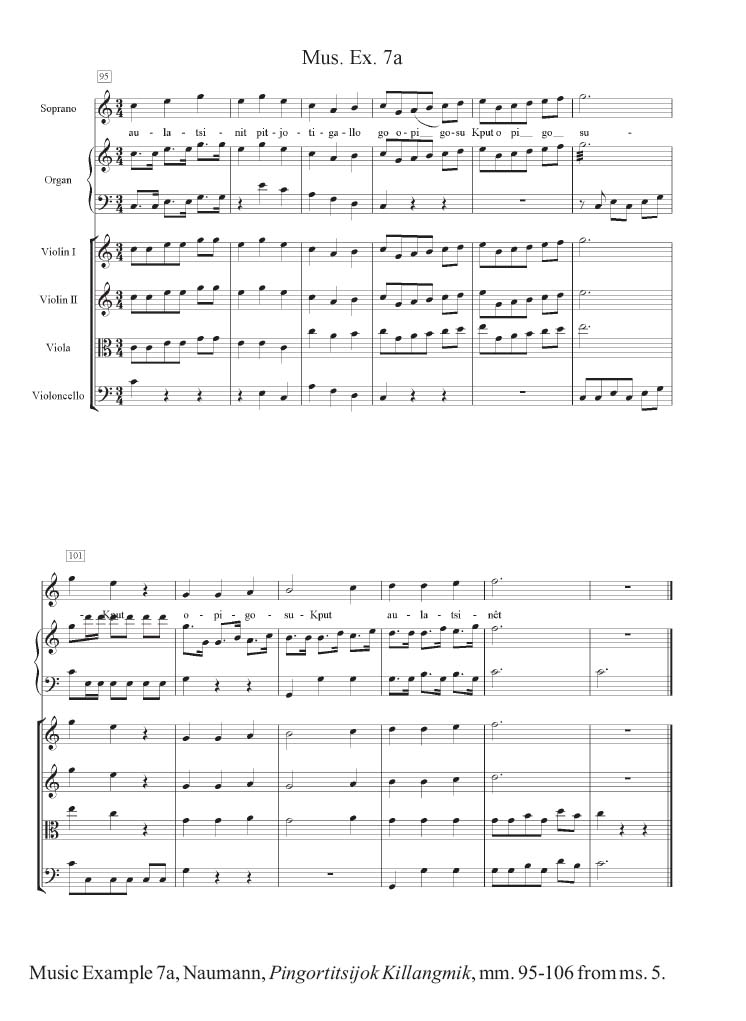
Display large image of Figure 14

Display large image of Figure 15
36 As the nineteenth century progressed, members of the church hierarchy were occasional passengers on the annual mission ship voyage. Their observations offer the perspective of a distance that resident missionaries could not achieve on the musical accomplishments of the Inuit. A detailed account from the second half of the century was penned by the Reverend Benjamin Henry Latrobe16 following his journey. His observations on musical activity at the Hopedale mission are typical:The little organ is played by Ludolf, an Eskimo, well and devotionally, and the singing is further accompanied by other musicians with one clarionet, five violins, and a violoncello. The choice of tunes is such as would puzzle most congregations in England. The people are very devout in their demeanour and sing well ... The next service was commenced with a choir piece, when the organ and other instruments accompanied seven singers, four women and three men. The women especially had voices of power and compass. Alto, tenor, and bass were fairly sustained, as well as soprano, and the whole effect was good. The piece, which was not easy, but suitable in liturgical character, was well rendered both in forte and piano passages. This time Ambrose, another native, presided at the organ, and Ludolf played the first violin. (Latrobe 12-14)While we learn a good deal about the size of the choir and instrumental ensemble in this citation, it is again the quality of the singing and the skills of the Inuit musicians that attract attention. The description of the women’s voices of "power and compass" is especially notable.
37 In addition to underscoring a natural affinity to part-singing, these accounts draw attention to the Inuit interest in blended sonority in general. The arrival of the first organs on the Labrador coast was a moment of great significance in each community. Nain was the first congregation to receive an instrument, which arrived in 1824, the gift of the church in Herrnhut. The instrument was a source of great interest to the Inuit, many of whom travelled from other communities to hear it.When visitors from the other congregations at Okak and Hopedale attend our services, they are much struck with the effect of the organ, and loudly testify their gratification. An Esquimaux, from the former place, expressed himself as follows: "How happy I feel; I am reminded, by what I have heard, of Jesus and of the company of the saved, who surround His throne, and sing his praises. There are indeed delightful notes, which I shall not soon forget." Some of the more intelligent of our people have come to me, and requested that I would show them the interior, and explain the construction of the instrument. This being done, their wonder has been extreme. (Morhardt 1830)
38 While the Inuit expressed their musical preferences without reserve, they also made clear to the missionaries the aspects of the Moravian music tradition that they found incomprehensible. Chief among these was its elaborate rhythmic complexity. The Inuit resistance to the constructed rhythms of western art music was a much remarked source of frustration to their missionary mentors, as noted in this 1826 journal entry by Johann Ludwig Morhardt:Being appointed both school-master and music-director, (as there is no better), I have enough to do, both with my pen and my schools, but it is a pleasure to me to serve the youth. I wish we had more violins, and a violoncello. As likewise a larger assortment of strings; for I perceive, that it is well worth the while to teach the Esquimaux music, and our labour is not in vain. The most difficult part is keeping time, and that seems to puzzle them exceedingly. When seven years ago, I made a beginning to teach two young Esquimaux the violin, one of them grew so peevish about keeping time, that he declared, that it was impossible to learn it; but he is now one of my best scholars. (Morhardt 1826)Arbitrarily or artificially measured time was a concept inimical to the Inuit. Their language contained no terms for even the macro-measures of conceptualized time: days, weeks, years. Only that which partook of natural cycles and rhythms had names. Thus the wholly arbitrary micro-measurement of time represented in beats, metres, rhythms would represent an alien and inessential construct. The drum beat time, rather than measuring it. It should be no surprise, then, that numerous missionary reports chronicle the Inuit musicians’ resistance to the mastery of Western music’s constructed rhythms.
39 Sonority, on the other hand held great attractions. The ready assimilation of four-part harmonic singing, as represented in the chorale tradition, seems to identify the receptivity to the sonorous and harmonic in this music.The singing, both of our little choir, and of the congregation, is very pleasing; and our people evidently take great delight in this enlivening portion of the Christian worship. Their predilection for extreme simplicity of accompaniment is remarkable, and their example in this particular is not unworthy of the attention of their more civilized Brethren in Europe. (Morhardt 1830)
40 The remarkable predilection for pleasing singing supported by extremely simple accompaniment characterizes the found voice of the Inuit in the Moravian anthem repertoire. This voice emerged across a chain of manuscripts copied and recopied from one another. Late in the eighteenth century a small band of musically literate missionaries had begun whispering the secrets of a repertoire of European sacred music into the receptive ears of the Inuit of Labrador. This was not an innocent act. The Moravians knew that music was a powerful means of expression of their religious sentiment and belief. They rejoiced in the Inuit receptivity to European music, recognizing it as a powerful tool in their campaign of conversion. But as they presented the Inuit with this repertoire of music and the ability to perform it, they also imparted to them the power to transform it. At the end of a chain of copying and re-copying this repertoire across 200 years, we see and hear a music that has assumed the identity of the voice which intones it.
References
Barr, Alfred H. Picasso, Fifty Years of his Art. New York: The Museum of Modern Art, 1946.
Cumnock, Frances, ed. Catalog of the Salem Congregation Music. Chapel Hill: University of North Carolina Press, 1980.
Fox, Pauline. "Parodies for Piety: ‘aus Naumanns Cora’." Moravian Music Journal 42.2 (1997): 6-14.
Gombosi, Marilyn, ed. Catalog of the Johannes Herbst Collection. Chapel Hill: The University of North Carolina Press, 1970.
Kohlmeister, Benjamin and George Kmoch. Journal of a Voyage from Okkak, on the Coast of Labrador, to Ungava Bay, Westward of Cape Chudleigh; Undertaken to explore the Coast, and visit the Esquimaux in that unknown Region. www.mun.ca/ rels/ morav/texts/ungava/ungava.html
Kruth, F[erdinand], Letter from Hebron, Periodical Accounts, Vol. 15, (1839-41), 304-306.
Latrobe, Benjamin. With the Harmony to Labrador; Notes Of A Visit To The Moravian Mission Stations On The North-East Coast Of Labrador. London: Moravian Church and Mission Agency, [1888] Project Gutenberg [www.gutenberg.net]: E-book #15190, 27 February 2005.
M[orhardt, J[ohann] L[udwig]. "Journal entry, from Hopedale, 1826." Periodical Accounts 10 ([1826]): 66-67.
Morhardt, [Johann] L[udwig]."Journal entry, from Nain, 1830." Periodical Accounts 11 ([1829]): 381-382.
Steelman, Robert, ed. Lititz Congregation Collection. Chapel Hill: The University of North Carolina Press, 1981.
Stock, T.P., J. Korner, and F.C. Fritsch. "Letter from Hopedale, September 9th, 1828." Periodical Accounts 10 ([1826]): 444.
Stravinsky, Igor and Robert Craft. Expositions and Developments. Berkeley: University of California Press, 1962.
Notes
